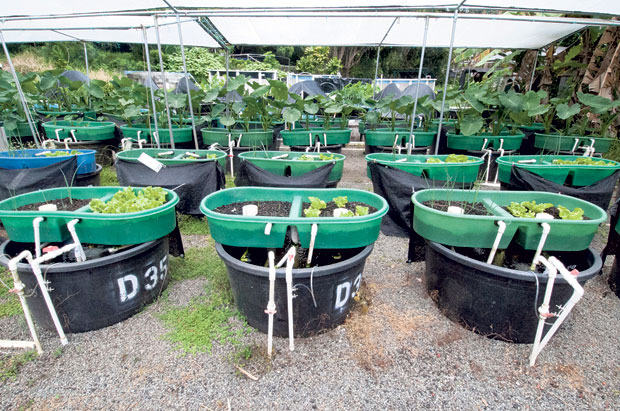More and more people are immersing themselves in aquaponics, intent on producing their own food through this sustainable farming practice.
These days, you don’t need a farm or even a yard to grow some crops. With aquaponics — defined as the symbiotic cultivation of plants and aquatic animals in a circulating system — more and more people are becoming urban gardeners, growing their own food in just about any shape or size of space, including small apartments and condos.

“Aquaponics is a merger of two kinds of technology — aquaculture and hydroponics. It’s basically soil-less farming,” explained Clyde Tamaru, extension specialist at the UH Manoa College of Tropical Agriculture and Human Resources (CTAHR). “Right now there’s a big movement in aquaponics. A lot of people are jumping on board and a large part of it is that soil is not required.
“There also are a lot of other benefits. There are no weeds, and because there’s no soil, you don’t get dirty. And you can grow pretty much anything — lettuce, tomato, cucumber, chili pepper, basil, green onion, taro, etc. And if you wanted to, you can do it from indoors, but it requires artificial lighting.”
Depending on your budget and space, a home aquaponic system can be very basic or super fancy. The main components needed are a fish tank, water pump, grow bed, growing medium, fish and plants. You can build one yourself or buy a ready-made unit that will be up and running right away.
From the time your system is built, Tamaru said it takes about six weeks to start seeing crops from seeds, or four weeks with starter plants from lawn and garden shops. As for maintenance, there are live fish, so it’s like taking care of a pet. But it’s still considered to be much, much less work than maintaining a dirt garden.

“A lot of people think building an aquaponic system is costly, but it’s about the same price as putting together a fancy aquarium,” said Tamaru, noting that green onion, leafy greens and basil are the easiest to grow. As for types of fish, the best include tilapia, koi, fancy goldfish, carp and ornamental types such as angelfish, guppies and tetras. “Aquaponics is an emerging technology that I think we all need to take a really hard look at because on our island we have limitations of water and space, and this kind of technology is pretty much trying to adjust to those things.
“Also, I think a reason for the big movement is people want to practice sustainability. This whole thing about the three Rs — reduce, recycle, reuse — that basically describes aquaponics. It’s becoming self-reliant by producing your own food.”
ANCIENT ROOTS: Did you know the Aztec chinampas farming system is considered by some to be the first example of aquaponics? | Source: TheGardenPool.org
WCC to Host Aquaponics Conference
You can learn more about aquaponics during a May 25 conference at Windward Community College, Hale Akoakoa, from 9 a.m. to 5:30 p.m.
Presented by the Hawaii Aquaculture and Aquaponics Association, Windward Community College and CTAHR, the conference will feature some of Hawaii’s most knowledgeable commercial aquaponic producers, urban garden producers, aquaponic service providers and community groups discussing the challenges and opportunities of aquaponic operations in Hawaii. There also will be faculty members from CTAHR sharing the latest developments in aquaponic research and extension being conducted by the college, and a representative from isisHawaii talking about the role of aquaponics in education.
Cost for the conference is $79 (early-bird rate) or $99 (regular rate). For more information or to register, visit www.aquasustainability.com.